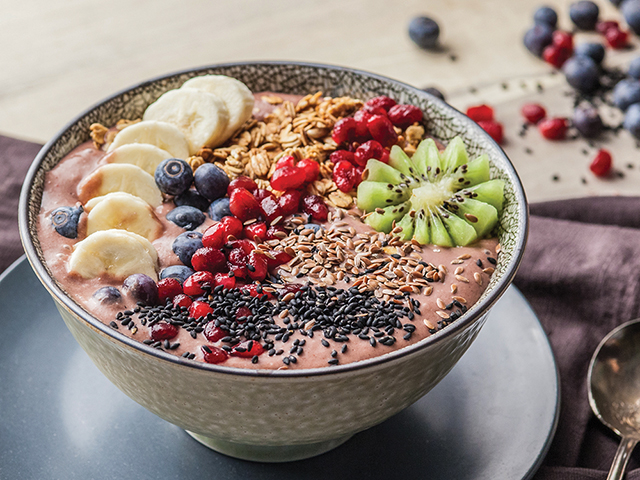
If you follow any of the popular fitness or travel accounts on Instagram, there’s no doubt you will have seen numerous pictures of vibrant purple smoothie bowls scattered throughout your newsfeed in recent times. These colourful bowls always look like pieces of art, decorated with star shaped berries, delicious granola and rows of carefully positioned banana slices. How come whenever we try and recreate these smoothie bowls, they seem to lack the bright, colourful goodness?
The secret ingredient, which is a rare find in our corner of the world, is the acai berry (pronounced ah-SIGH-ee). Grown on acai palms in Brazil, these berries are a dietary staple in South America and have been used medicinally by Amazonian tribes.
When acai was originally introduced to the Western world, it was marketed as ‘purple gold’, a magic fruit that would cleanse your body of ‘toxins’, a new cure for losing weight and removing wrinkles. Naturally, these claims have been taken to the extreme. Like any other fruit, it is full of antioxidants, fibre and healthy fats and is a great addition to a balanced diet. With its main advantage being it makes beautiful insta-worthy smoothie bowls.
Acai cannot be found in your typical supermarket due to their rapid degeneration once harvested. However, the good news is that thanks to flash freezing developments in recent years, it can be frozen immediately, retaining all its nutrients and shipped around the world. Countries like Australia and Bali are massive consumers of acai. The trend is slowly beginning to trickle into Europe, with a number of cafés in Dublin beginning to sell acai bowls.
Pog, a health food café situated right beside O’Connell bridge prides itself on selling produce with the aim to show people that “living a healthy lifestyle wasn’t just 6am hill sprints and tasteless rabbit food”.
Often acai bowls are made with frozen banana and coconut milk, with the addition of the frozen acai of course. The Pog acai bowl is a beautiful bright pink and tastes similar to raspberry sorbet, which suggests it was possibly made with frozen mixed berries instead of banana, another popular combo with the “purple gold”.
Eathos, a café on Baggot St, provides a similar kind of acai bowl, however their toppings earn them some extra brownie points. Covered in a layer of hearty granola, passionfruit, coconut and drizzled with honey, it’s almost too pretty to eat.
Finally, new to the foodie scene in Dublin, Klaw Poke is “bringin’ crabshack style dining to the city” and have squeezed an acai bowl onto their predominantly ‘fishy’ food menu. If you’re in the city and fancy an acai bowl, definitely consider popping in there. Their acai bowls are even available in a small takeaway bowl so you can bring yours with you en route to your next shopping spot, or just strolling the streets of Temple Bar. Once the sun comes out in a few months, an acai bowl will make the perfect lunchtime treat, who needs to go to Hawaii for those tropical vibes anyway.
Cauliflower power
Cauliflower is often found in the big bowl of veg at family roast dinners, which is passed around and around until abandoned, not even empty. Sometimes it is served covered in a creamy white sauce or copious amounts of cheese. It’s pretty tasteless and looks equally as unappetising.
However, cauliflower is coming back into fashion. Many of the leading foodies like the Happy Pear are getting more creative with food, offering countless vegetarian and vegan recipes that won’t bore your socks off and don’t involve drowning the dish in mozzarella. Veering away from many of the carbohydrate dense products like rice, noodles and bread, those looking to lose weight or even just incorporate nutrient-rich foods into their diet are turning to plant-based alternatives. Spiralized courgette and sweet potato can now be found lining the vegetable aisles in many supermarkets across the country. It is even possible to buy apparatus to spiralise these veggies yourself, providing a delicious alternative to rice noodles for those looking to lower their carb intake.
Cauliflower rice is another trend following closely behind that of spiralized sweet potato. A quick Google search will display countless recipes on how to whizz this steamed vegetable up in a blender to produce fluffy “cauliflower rice”, which can be served with your usual curry, stir-fry or whatever tickles your fancy. It is not only a fantastic source of vitamin C, but also a source of anti-inflammatory nutrients. Replacing a portion of starchy rice with this veggie alternative can only improve your diet.
Cauliflower is also being used for its texture and to add bulk to baking recipes. Yes, cauliflower brownies are now a thing. Other vegetables such as beetroot and avocado are also being used in baking to add moisture without having to throw in half a tub of butter. Even in smoothie bowls, frozen cauliflower can be added to replace banana or mango, in order to thicken a recipe. Berries, honey and protein powders can then be added to mask the flavour and make this pale vegetable a bright blue, or vivid pink.
Some people may turn their nose up at the idea, for there’s nothing wrong with indulging in some baked goods that don’t contain half the contents of your grocery shop – let’s be honest, who really wants cauliflower for breakfast? On the other hand, for people looking to enjoy a sweet treat without their daily calorie intake skyrocketing, a slice of dairy-free raspberry cauliflower cheesecake may just be the way to go.
Laura O’Mahony
Image credit: Pinterest
